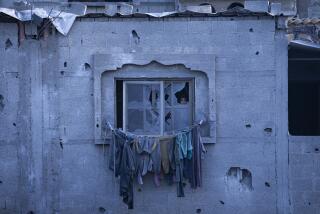Legal effort over injured American seeks compensation of Israel
- Share via
Reporting from Jerusalem — Tristan Anderson visited Israel and the West Bank in 2009 with his girlfriend, a Jewish American activist, to participate in pro-Palestinian demonstrations and see the Mideast conflict firsthand.
The Oakland man left with brain damage, partial paralysis and blindness in one eye after being hit in the head with a high-velocity tear-gas canister during a protest against Israel’s separation barrier in the West Bank village of Nilin.
Now Anderson, 40, and his parents are pressing the Israeli government to pay for his rehabilitation and 24-hour care in a multimillion-dollar civil lawsuit.
Anderson’s girlfriend, Gabrielle Silverman, who was with him when he was injured, returned to Israel last month to act as a family representative during the first phase of the trial because he is not well enough to travel. Anderson uses a wheelchair and suffers from impaired judgment.
The trial, which was set to begin Nov. 17, has been indefinitely postponed.
“Tristan is going to need care for the rest of his life and we need to make sure his needs are met,” said Silverman, 28, a healthcare worker also from Oakland.
“We need them to take responsibility for this,” she said. “We want answers and justice. This is our only opportunity to put these people on the witness stand.”
The family says an Israeli border guard intentionally aimed a metal tear-gas canister at Anderson during one of the weekly protests that take place in Nilin and other West Bank villages. The demonstrations usually end in clashes between rock-throwing Palestinians and Israeli security forces, who fire tear gas, rubber bullets and water cannons.
An Israeli investigation of the incident concluded last year that there was no criminal intent by the border guard, and no charges were filed.
“There was no finding that anyone intentionally tried to hurt Mr. Anderson, only to shoot the tear gas to disperse the people,” Israeli Justice Ministry spokesman Ron Roman said. But at the family’s request, the ministry agreed to review its decision.
Israeli officials have refused to apologize or pay damages because they say Anderson put himself in danger by refusing to leave the area, which Israeli forces had declared a closed military zone.
“The riots are illegal,” said Israel Defense Forces spokeswoman Lt. Col. Avital Leibovitz. “We don’t have a problem with people holding signs or yelling their beliefs. But 95% of the time, we see people trying to take down the fence, throwing Molotov cocktails and hurling rocks.”
Silverman said the March 2009 protest that she and Anderson attended was winding down and most of the participants had gone home. Anderson was taking photographs and talking with a small group of people when Israeli forces fired tear gas at them, she said. After Anderson was severely injured, Silverman said, Israeli forces delayed his ambulance at a checkpoint.
After spending months in an Israeli hospital, he was well enough to return to California last year.
Anderson remembers little about the trip or the incident, one of many gaps in his memory. He recognizes his friends and family and regained his ability to speak with his former vocabulary, Silverman said. But his problems include often being unable to control his impulses and emotions.
“He functions like a child,” said Israeli attorney Leah Tsemel, who is representing the Andersons. “He won’t marry or be a father or have a future. Nothing they pay will ever cover the expenses for the physical and mental damage.”
The Anderson family has not specified how much they are seeking in compensation. Tristan Anderson worked installing trade-show booths in Oakland before being injured.
Tsemel recently won a $430,000 judgment against Israel on behalf of the family of a Palestinian girl, Abir Aramin, who was killed in 2007 by a rubber bullet fired by an Israeli border guard during an East Jerusalem clash.
Leaders of the Israeli human rights group B’Tselem said that the type of tear-gas canister that struck Anderson was particularly dangerous and was phased out by the Israeli military after injuries and fatalities ocurred, including the 2009 death of Palestinian activist Bassam Abu Rahme, who was struck in the chest by the same kind of projectile.
“We think the army stopped using these canisters because it became clear to the military operational echelon that their use is a problem and dangerous,” said B’Tselem spokeswoman Sarit Michaeli.
She said the high-velocity metal canisters, manufactured in the United States, were more lethal than aluminum or rubber canisters, and were designed to be used at long distance and to break through windows and drywall, not for close situations.
Michaeli said her group has collected data on many cases of Israeli security forces firing tear-gas canisters directly at protesters, even though the practice violates military policy.
“There’s a lack of accountability because it’s extremely rare that the authorities ever do anything to stop it when it happens,” she said.
This spring, New York student Emily Henochowicz, 21, who was visiting Israel as an exchange student, lost an eye when she was struck with a different type of tear-gas canister during a demonstration against Israel’s May 2010 takeover of a pro-Palestinian flotilla, including the Mavi Marmara vessel.
Military officials would not comment on whether they had changed their use of tear-gas canisters, citing the pending lawsuit. But they denied intentionally targeting civilian protesters and said the military tries to use nonlethal means to disperse demonstrations.
More to Read
Sign up for Essential California
The most important California stories and recommendations in your inbox every morning.
You may occasionally receive promotional content from the Los Angeles Times.










